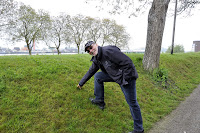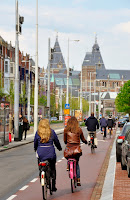A Dutch
Treat
It was one of
the busiest travel days in the European calendar, Whit Monday (Monday
of the Holy Spirit) and the trains were plugged full. People and
their luggage were everywhere.
But it really
didn't matter!
 |
| Tineke and Herman's beautiful house. |
We were sparked. Soon we'd be in Hengelo, Holland
with Linda's cousins, Tineke and Herman, and their family.
So let's meet the family:
This is Tineke, Linda's cousin,
her daughter, Birthe,
and Herman, her husband.
Next to his favourite car in the world, an Audi of course,
is Jan-Willem.
Named after both his grandfathers, Jan-Willem, the youngest, is a tool and die specialist and will soon be studying to become a computer specialist in this area.
Kirsten and Caroline always have a beautiful ready smile. On this day, it happened to be Caroline's birthday.
Kirsten has finished her studies in law and will be beginning a degree in Education in September.
Caroline has just completed her studies to become a gold smith.
And this is Birthe, the first of the four children.
She works in Herman's Custom Pharmacy and Hospital Interiors Business.
Everyone in the family speaks extraordinarily good English.
And oh yes, let's not forget Mads, the family dog.
His English is not so good, nor is his Dutch.
But still, like most dogs, he's still a master of communication.
We all had such fun. Particularly interesting were all the discussions in the kitchen or around the dining room table. It really did feel like home.
.jpg) |
We were going to do some sight seeing but
first we had to get the Ol' Timer ready for action. |
Did you know that the Netherlands was ranked first as the world's "happiest" country?
That could be why our stay really was a “Dutch Treat”.
The star of the show was Herman's Ol' Timer (a Citroen DS) which does get out from time to time.
The DS (pronounced déesse, French for “goddess”), is a green scarab-shaped, streamlined automobile.
Herman and Tineke spared no expense showing us as much of the Holland they love as possible.
.jpg) And off we went!!!
And off we went!!!
Only as big as mainland Nova Scotia, its population of 17 million, but enjoys so much diversity and beauty that it's impossible to see and do everything during our stay.
 |
| The Twente home completly restored. |
A highlight
was our visit to Herman's mother's, the children's grandmother's
beautiful home in the beautiful countryside of Twente.
 |
| Inside the home. |
 |
Kirsten with her grandmother
in her beautiful restored home. |
In an attempt
to save its rich but decaying heritage, the local government leased
out a number of its historical farm properties.
Herman and his family took part in the program and are now leasing this property which they have since restored.
 |
Here we are at Twente Castle, just minutes
down the road from gramma's house. |
The house and
its land have been home to Herman's parents and whole family now for
over a quarter of a century.
 |
| A front view of the "Twente Castle". |
Hengelo is in the eastern region, in the region of Twente, where we found this beautiful castle.
 |
| The castle guard!!!! |
There are so many ways to get around but the bicycle is certainly no cliché and a very popular mode of transportation.
.jpg)
Historically a factory town, Hengelo specialized in metal products while Enchede, a near-by sister town, specialized in cloth manufacturing.
Old Walls.... New Ideas
 |
| A mill in Enchede before at the height of the industrial period. |
Needless to
say that during World War II, this manufacturing hub fell into the
hands of the Germans.
Its railways and industries then became part of
the Nazi war machine and....
..... then a target of the Allies.
 |
Today, that same hall has been transformed
into a technical college. |
During a raid in 1944, the heart of the town was accidentally bombed,
killing several hundred people.
Both Hengelo and Enchede did rebuild...
 |
| A new start for Enchede and Hengelo. |
....but in the end, the industrial base of both towns transferred out to lands of cheaper labour.
New vocations
for the towns had to be found.
Miraculously,
many of the old factories that closed,
were not torn down....
....but rather integrated into the towns' new lives...
becoming museums, universities, high tech industries, and of course, homes and community centres.
 |
Like Hans Brinker, I'm saving Holland
by keeping my thumb in the dyke.
Some one has to do it.
|
Despite it's
very intense population density of 466 people per square kilometer,
Holland is very green and....of
course, full of water.
The
Netherlands (meaning “low country”) is a geographically low-lying
country, a delta to three large rivers. About 20% of its area and population are below sea level.
 |
The water on the left of the dike is higher
than the land on the right.
|
Surprisingly, most of this problem is man-made.
You see, Holland had no
coal or forests to burn for heat in winter. Peat was the answer.
Centuries
of extensive and poorly controlled peat extraction, lowered the surface level by several meters.
To win land back, dikes, canals
and pumping stations were the answer.
Five "Did you know that..."'s about Holland
1. The Nederlands is the largest beer exporter in the world.
In 2001, Dutch beer companies exported an astonishing volume of 1.3 billion liters of beer abroad. Half of that was shipped to the U.S.!
2. Dutch people are the tallest in the world.
With
an average height of 184 cm for men and 170 cm for women, Dutchies
are the tallest people in the world.
3. The
Netherlands is the most densely populated nation in Europe.
With
487 inhabitants per square kilometer, the Netherlands has the
highest population density of
4. Amsterdam is built entirely on poles.
Because
Amsterdam's soil consists of a thick layer of fen and clay, all
buildings are built on wooden poles that are fixed in a sandy layer
that is 11 meters deep on average. The Royal Palace at Dam Square is
built on no less than 13,659 wooden poles.
5. Turkish
Tulips?
Tulips, tulip fields and flower bulbs are typically
Dutch. Yet, tulips do not originate from the Netherlands. The first
tulip bulbs were imported from Turkey to the Netherlands, where they
proved to grow extremely well on Dutch soil.
And here are some people who made our days even brighter:
.jpg) |
| Charles, Herman, Henri, Kirsten, Margaret, and Tineke in Schoonhoven |
 |
| Beautiful Schoonhoven |
 |
Peter, a school principal in Enchede,
who graced us with wonderful coffee
and a wonderful discussion about the
Dutch school system.
|
 |
Munsterhaus, where we saw some very
expensive and most beautiful cars.
|
.jpg) |
Tijmen, Caroline's boy friend, who along
with her spent a cold but profitable day at
their booth in Schoonhoven. Both are very
accomplished "prize-winning" gold smiths.
|
 |
Karen, Tineke's sister, who came to join us
in Schoonhoven. We'll be staying with her
in Utrecht next week.
|
More to come.
Until next time.
.jpg)
.jpg)
.jpg) Situated
in the heart of Holland, the city was
Situated
in the heart of Holland, the city was .jpg) Situated
in the heart of Holland, the city was
Situated
in the heart of Holland, the city was 
.jpg)
.jpg)
.jpg)
.jpg)
.jpg)
.jpg)

.jpg)

.jpg)
.jpg)

+(500x800).jpg)
.jpg)
.jpg)
.jpg)


.jpg)
.jpg)
.jpg)
.jpg)

.jpg)
.jpg)
.jpg)







.jpg)





.jpg)



.jpg)













.jpg)
.jpg)
.jpg)


.jpg)